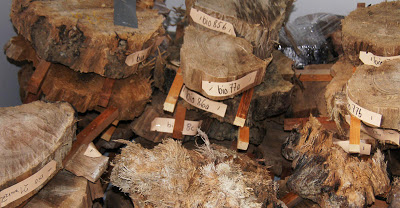
The fact that many finds have happened by chance was demonstrated again recently in Zurich. Daniel Nievergelt, a dendrochronologist at the Swiss Federal Institute for Forest, Snow and Landscape Research WSL, was just having a look at a building site on the southern edge of the city. He knew there was some justification for hope of a spectacular discovery from his collaboration with his colleague Felix Kaiser, who died in 2012 and who in 1999 had already found subfossil* wood during the excavation of the Uetliberg Highway Tunnel.
The researcher took a closer examination of a few tree stumps on the edge of the loamy building pit in the neighborhood of Zurich Binz that had been discarded by the construction workers as waste timber. He found they were pine trees, and immediately investigated them further with colleagues from the WSL. He also sent three samples to the Swiss Federal Institute of Technology (ETH), where they were C14-dated. This confirmed his suspicions: the timber was discovered to go back to between 12,846 BP** and 13,782 BP. With the support of the building-site management, to date the WSL researchers have managed to salvage some 200 pine-tree stumps, which they have had transported in truckloads to the WSL. To the knowledge of the researchers involved, the quality and scale of the find are unique worldwide.
What the find could mean for science
WSL runs one of the leading laboratories for tree-ring research (dendrochronology) worldwide, making a significant contribution to research work in a wide range of disciplines. The most recent finds are being incorporated into a global database of environmental archives and may provide important information about a number of research questions: What was the climate like after the last Ice Age? What events left a mark on the area around Zurich and Earth in general? What is the genetic relationship between the Zurich Binz pines and their cognates today? In addition, the prehistoric wood in Zurich Binz could help in the calibration of the C14 curve.
The tree rings and condition and location of the discovered stumps allow conclusions to be drawn about past fluctuations in temperature and precipitation and attest to disturbances such as fires, storms and earthquakes. The density and chemical composition of the wood may provide clues to the climate and air composition in the past. And since relatively recently, aDNA analysis allow trees’ evolution to be traced.
All the data produced to be published
The WSL researchers are now sawing three sections from each useable stump and are analyzing the wood and the rings in their own laboratories and in those of their partners. The scientists will first try to add to the Central European dendrochronology chart (see image). This dataset contains dated tree rings going back to 12594 BP. The finds that have been made up to now in Zurich are from the period from 12700 BP to 14100 BP. Through meticulous comparison of tree-ring patterns, efforts are now being made to identify the overlaps needed for precise dating. Perhaps the new-found timbers can fill a gap and extend the chronology by around 2,000 years. Whatever the case may be, the timbers discovered in Zurich Binz and the data arising from their analysis are of invaluable scientific importance. In the tradition of open scientific exchange, the WSL will gradually make such data public, for instance through the International Tree-Ring Data Bank (ITRDB), which for decades now has been supplied with a wealth of data by the WSL’s tree-ring laboratory and its founder, Fritz Schweingruber.
* Subfossil = any prehistoric organism which has not fossilized, or only partially. Unlike fossils, subfossils can be dated using the C14 method (source: Wikipedia).
** BP = Before Present: a time-scale that is used in archaeology, geology and other sciences to date events in the past. Since ‘the present’ is constantly changing, international consensus was reached on making 1 January 1950 or the calendar year 1950 the point of reference (source: Wikipedia).










